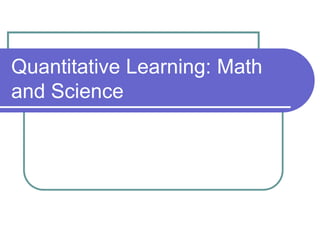Quantitative learning
- 1. Quantitative Learning: Math and Science
- 2. Uses of Math and Science in Life Arithmetic Keeping your checkbook. Figuring a tip at a restaurant. Doing your income tax returns. Algebra Calculating interest on a loan. Computing your GPA.
- 3. Geometry Deciding how much paint or carpeting to buy. Deciding how much fencing you need to enclose your yard. Deciding if and how your new furniture will fit into your room. Probability and Statistics Understanding health risks. Understanding and making business decisions.
- 4. Calculus and Differential Equations Needed for engineering, business, economics, physics, astronomy. Used for problems that involve work, water pressure, etc. Sciences Help in understanding yourself and the world you live in.
- 5. Facts about college math and science courses: Assignments are crucial. Class time may focus more on theories and ideas than on problem- solving. Class size may be larger. Knowledge of technology may be important.
- 6. Effective Use of Math and Science Textbooks Involves: Recognizing that material is presented sequentially. Taking notes, working examples yourself, identifying things you don’t understand. Paying attention to formulas. Using memory techniques, especially in learning new vocabulary. Learning the language of the discipline. Keeping up with reading and homework.
- 7. Studying and Homework Review materials regularly and often. Do problems, problems, more problems. Don’t let frustration stop you. Work with a partner or study group. Use what you know about your learning styles.
- 8. Steps in Solving Word Problems 1. Read the problem carefully and understand what it is asking. 2. Relate to problems you have done and identify possible solutions. 3. Pick a way to solve the problem and do it. 4. Review your results.
- 9. PROBLEM-SOLVING STRATEGIES Look for a pattern. Make a table. Break into smaller parts. Check a similar problem. Work backwards. Draw a table/diagram. Translate words into an equation.
- 10. OVERCOMING MATH ANXIETY Practice, practice, practice. Use resources. Take responsibility. Learn and use relaxation techniques. Adopt a positive attitude.
- 11. Math and Science Test-Taking Tips Read through the entire exam first. Analyze problems carefully. Estimate an approximate answer before working the problem. Break solution into smallest possible steps. Draw a picture to help you see the problem. Be neat. Use the opposite operation to check your work. Look back at the question to be sure you followed directions.
- 12. Visual Aids Provide a lot of information in an easy to understand form in a relatively small amount of space. Show trends over time. Show relative rankings. Show distributions. Show cycles.
- 13. TYPES OF VISUALS Tables. Pie charts. Bar graphs. Line graphs. Diagrams.
